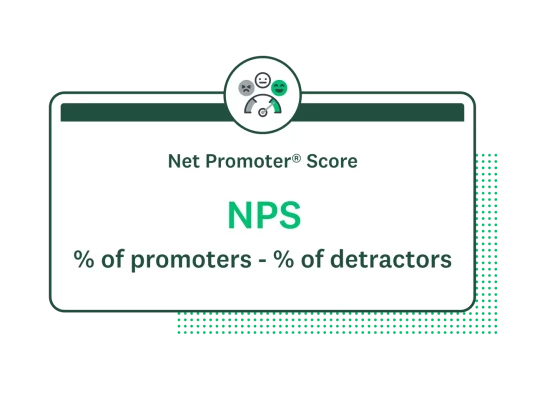Net promoter score: Calculation, survey tips, and best practices
Measure customer satisfaction with a Net Promoter Score survey. Learn how to calculate it, and get tips for creating an effective NPS survey.

How can I tell if my customers are truly loyal? What's the best way to use their feedback to grow?
The Net Promoter Score (NPS®) is a powerful tool designed to answer these questions directly. It measures customer loyalty by asking one simple question, providing a clear CX metric that helps you understand customer sentiment.
By tracking NPS regularly, you can pinpoint which customer experience strategies are working and make informed decisions that directly impact your business's growth and success. This makes NPS more than just a score—it's a critical tool for driving business forward.
What is Net Promoter Score (NPS)?
The Net Promoter Score is a metric used to measure customer loyalty and satisfaction. It's based on one simple, powerful NPS question: "How likely are you to recommend our product/service to a friend or colleague?"
This question asks customers to rate their likelihood of recommending you on a scale from 0 to 10. The score you get from this, which ranges from -100 to 100, gives you a clear snapshot of your customer base, helping you understand their overall sentiment.
Why is Net Promoter Score important?
- NPS measures customer loyalty. At its core, NPS shows how loyal your customers are. A high score correlates with increased revenue, higher retention, and a stronger brand reputation.
- NPS benchmarks your progress. By comparing your NPS score against your own past results or industry standards, you can quickly gauge your performance against competitors and identify opportunities for growth.
- NPS is simple and quick. One question is all it takes to determine your score, which streamlines data collection and makes reporting on customer sentiment much easier.
- NPS identifies promoters, detractors, and passives. Classifying your customer base into these three key categories allows you to create targeted feedback initiatives, reduce customer churn, and boost sales through referrals.
- NPS is easy to understand. Scored from -100 to 100, NPS is an intuitive metric that simplifies the process of communicating customer sentiment and gaining buy-in from stakeholders and business leaders.
- NPS is repeatable. By collecting NPS data regularly, you can track the effectiveness of your customer experience strategies and monitor the impact of business decisions on customer satisfaction over time.
Conducting NPS surveys will allow your business to better understand customers' feelings about your customer experience efforts. You can create an actionable plan to enhance your customer experiences by conducting follow-ups with less satisfied segments.
Related reading: Why use NPS?
How to calculate your NPS
To calculate your NPS, subtract the total percentage of detractors from the total percentage of promoters (% of promoters - % of detractors.)
You’ll get a score ranging from -100 to 100. This result is your NPS.

Related reading: How to calculate NPS - Net Promoter Score calculation guide
Here’s our step-by-step breakdown:
- Send your NPS survey to your target demographic.
- Count the responses that fall into the promoter category (scores of 9-10) and the number of detractors (scores of 0-6). Ignore the passives; they’re not included in the NPS calculation because they don’t impact customer loyalty directly.
- Find the percentage of promoters and detractors: divide the number of promoters and detractors by the total responses, then multiply by 100.
- Subtract the percentage of detractors from the percentage of promoters.
Imagine you received 200 responses to your NPS survey:
- 20 responses were in the 0–6 range (detractors.)
- 40 responses were in the 7–8 range (passives.)
- 140 responses were in the 9–10 range (promoters.)
To determine the percentage of your detractors and promoters, divide each number by the total responses, then multiply the result by 100.
- 10% are detractors (20/200 = 0.1 x 100 = 10)
- 70% are promoters (140/200 = 0.7 x 100 = 70)
- Subtract 10% (detractors) from 70% (promoters). Your result is 60%.
Since a Net Promoter Score always appears as an integer and not a percentage, your NPS is 60.
Calculating NPS for a small group is easy, but it can get complex as your survey size increases. With the SurveyMonkey NPS template, the built-in NPS calculator ensures 100% accurate results faster.

NPS scale: Promoters, detractors, and passives
Understanding promoters, detractors, and passives is central to calculating your Net Promoter Score. Each group fulfills a unique role in your business, making these classifications important for customer feedback.
Promoters
Promoters are customers who respond with a 9 or 10. These are your most satisfied and loyal customers.
Promoters are your brand's biggest advocates, eager to recommend your business to others and contribute to a positive reputation. Their high score indicates they've had excellent experiences with your brand.
To leverage their positive sentiment, follow up with promoters to thank them for their feedback and encourage them to leave an online review or participate in a case study. Use their feedback to understand what your business is doing well and replicate those successes.
Detractors
NPS detractors are your dissatisfied customers who respond with an 0 to 6. They're unlikely to recommend your business and may even spread negative word-of-mouth, potentially hurting your brand's reputation and leading to customer churn. A low score here signals a negative experience with your brand.
To address their concerns, immediately follow up with detractors to understand what went wrong. Use their direct feedback to improve your customer experience and take action to resolve their issues, helping prevent churn and potentially converting detractors into promoters.
Passives
Passives are your indifferent customers with scores of 7 and 8 on the NPS scale. While they are satisfied with your products or services, they aren't loyal enough to actively promote your brand. This group is vulnerable to offers from competitors, making them a potential flight risk.
To convert passives into promoters, you should actively seek their feedback to uncover areas for improvement. By understanding their neutral customer experience, you can take targeted actions to address their needs and create a more compelling customer journey, encouraging them to become true brand advocates.
How to read and interpret your NPS
You’ve calculated your score, with positive scores indicating a loyal customer base and negative scores signaling an immediate need for attention.
However, understanding your NPS score goes beyond a single number; it's about interpreting what that score means for your business. Here's how you can effectively read and act on your results.
1. The NPS scale: A snapshot of your customer base
Your final NPS score is the percentage of promoters minus the percentage of detractors, giving you a number from -100 to +100.
- A positive score (above 0) is generally considered good, indicating you have more loyal customers than detractors.
- A score above +50 is excellent, signaling strong customer loyalty.
- A score of -100 means every customer is a Detractor, while a score of +100 means every customer is a Promoter.
2. Gather qualitative feedback
The true value of NPS lies in the qualitative feedback you collect. Always follow up the core NPS question with a request for a comment or explanation. This open-ended feedback reveals the "why" behind your score.
Are multiple customers mentioning a slow website, a great support team, or a new product feature? Grouping these comments will help you prioritize what to fix or what to highlight.
3. Segment your scores
Your overall NPS score is a powerful metric, but segmenting it by customer type can provide deeper insights.
- Segment by demographics: Compare NPS scores for different age groups, geographic locations, or industries.
- Segment by customer journey: Check NPS at different touchpoints, like after a purchase, following a support call, or after a product update. This helps you pinpoint specific areas of your customer experience that need improvement.
By dissecting your NPS data in this manner, you move beyond a single, overarching score to understand the nuances of your customer base.
This allows for more targeted strategies for improvement, personalized communication, and the allocation of resources to address specific pain points within particular demographic segments, ultimately leading to more effective customer experience enhancements.
4. Benchmark your score
To truly understand your performance, compare your NPS score to a relevant benchmark.
- Internal benchmarking: Track your score over time to see if your customer experience initiatives are having a positive impact.
- External benchmarking: Compare your score to industry averages to see how you stack up against competitors. This helps you determine if your score is a reflection of industry-wide trends or a unique issue with your business.To truly understand your performance and gain actionable insights, it's crucial to compare your Net Promoter Score to relevant benchmarks. This provides valuable context beyond just the raw score.
By combining both internal and external benchmarking, you gain a comprehensive understanding of your NPS performance, enabling you to make informed decisions that drive customer loyalty and business growth.
What is a good Net Promoter Score?
A good NPS score indicates that your customers are generally delighted with your business and have a good perception of your brand.
The optimal NPS score for your business will vary depending on its industry. For example, a good NPS score would be around +50 for a professional services or consumer goods company. However, a good NPS score comes in at +40 in the technology market.
Generally speaking, if your NPS score is 25 or below, your customers might not be satisfied with your brand. It’s a good idea to collect more feedback to pinpoint your customers’ sentiments.
Related reading: Net Promoter Score benchmarks: What is a good NPS?
What is a high Net Promoter Score?
A high NPS score indicates that your customers are generally satisfied with your company and that you consistently deliver products and services that they love.
For benchmarking purposes, a high NPS score for professional services and consumer goods is +72. For technology, a great NPS score is around +64. If your score resembles these or is even higher, you have a high NPS score, which suggests that your customers love your brand.
Again, NPS benchmarking will depend on many factors, including your industry. To accurately benchmark your company, track your NPS score over time to determine improvement.
Related reading: eNPS benchmarks: measure and improve employee engagement
How to conduct NPS surveys: Best practices for success
Now you know how powerful NPS surveys can be at enhancing customer experiences and boosting customer loyalty, it’s time to conduct your own. Here are our best practices for success when conducting an NPS survey:
Use follow-up questions
The NPS survey is effective due to its simplicity, taking only seconds to complete with a single question. However, this question only gauges satisfaction, not the reasons behind scores. For deeper insights, consider adding optional follow-up questions.
Include a mix of qualitative, open-ended questions that allow customers to share their sentiments in a comment box. A follow-up question could be as simple as, “Why did you give the score above?”
This will give customers the opportunity to add extra information that will provide context for their rating. Make sure to leave these as optional, as mandatory questions can take more time to complete and not everyone will want to give open-ended feedback.
Related reading: Transactional NPS vs. relational NPS
Consistently track NPS
Using NPS surveys provides a baseline for customer loyalty. While NPS benchmarking against competitors is helpful, tracking your NPS score over time offers a more effective analysis of your standing.
Your business should consistently send out NPS surveys at least once every quarter. A consistent stream of NPS data allows your business to demonstrate the effect of all your teams' customer experience improvements.
Send an NPS email to collect more responses
Use an NPS email to get more quality data as you collect your NPS on a consistent cadence.
An NPS email has proven effective for collecting more responses. Our research team found that simply embedding a question into the body of the email invitation increases the survey’s response rate by 22% and its completion rate by 19%.

Related reading: NPS surveys: Best practices for high response rates
Create an action plan
Use the feedback you collect from your NPS scores to build a customer experience strategy plan that satisfies more customers. As you implement their feedback, follow up with customers to show them you’re listening to their comments, which can win you even more promoters.
Applying your findings will help to improve your business processes. As these evolve, you’ll satisfy more customers and reach higher NPS scores.
Related video: Top NPS tips and common mistakes
NPS vs. other customer satisfaction metrics
Net Promoter Score, Customer Satisfaction Score (CSAT), and Customer Effort Score (CES) are three metrics that reveal different aspects of your overall customer experience. While they include distinct features, they all work together to give you a well-rounded view of your business health.
NPS vs. CSAT
As we’ve discussed, the NPS is a general measurement of customer loyalty. The NPS survey is great for quickly and accurately understanding customers' satisfaction with your business.
The CSAT score measures customer satisfaction with a specific part of your business, such as a product, checkout process, or customer support. It also measures how well you meet customer expectations for that aspect of their experience.
NPS vs. CES
CES quantifies how easily your customers can complete specific actions with your business. SurveyMonkey research suggests that 91% of customers will recommend a company with which they have a positive, low-effort experience.
While NPS generally measures customer satisfaction, CSAT and CES allow you to examine the specifics of how happy customers are with your products, services, and interactions.

Related reading: Customer experience metrics made simple
Create NPS surveys with SurveyMonkey
The Net Promoter Score (NPS) has become a global customer experience metric. It offers an easy, fast, and actionable way to measure customer loyalty, making it a vital metric to monitor.
With SurveyMonkey, you can instantly create effective NPS surveys and share them with your customers. Learn how SurveyMonkey’s all-in-one platform helps build and deploy NPS surveys that measure your Net Promoter Score.
Discover more resources

Solutions for your role
SurveyMonkey can help you do your job better. Discover how to make a bigger impact with winning strategies, products, experiences, and more.

Why are surveys important in research?
Surveys are important in research because they offer a flexible and dependable method of gathering crucial data. Learn more today.

NPS surveys: Best practices for high response rates
Learn NPS survey best practices to drive high response rates by improving survey processes.

23 ways to increase CSAT response rates
It's hard to improve your customer satisfaction scores without respondents. Get SurveyMonkey's best actionable tips to improve your response rate.
Ready to get started?
NPS, Net Promoter & Net Promoter Score are registered trademarks of Satmetrix Systems, Inc., Bain & Company and Fred Reichheld.